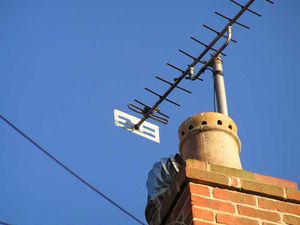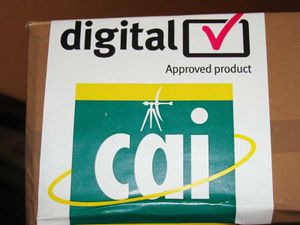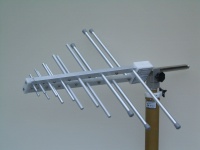Choosing a TV aerial
Contract Aerials
The most basic aerials (i.e. cheap!) are often referred to as "contract" grade aerials. These are typically of cheap light weight construction, and can usually be recognised by a reflector stamped out of a piece of sheet aluminium rather than being composed of several discrete elements.
CAI Approval
Many contract grade aerials and related equipment lack features which were not always necessary for adequate analogue reception, but are more important for good quality digital reception. The Confederation of Aerial Industries (CAI) have an accreditation scheme for "approved" equipment, including aerials which should have the required features.
So when choosing an aerial, look for one which:
- Is CAI approved
- Has a strong construction (if you're using it outdoors)
- Has a reflector made from several elements and not a simple perforated reflector plate stamped out of a flat sheet of metal.
- Includes a balun to ensure proper matching to the aerial downlead (although note that log periodic aerials don't require a separate balun).
Wideband aerials
Many aerials currently being sold are wideband. Wideband means it will receive the full range of TV transmission frequencies used in the UK, making them a safe (but not necessarily optimal) choice. Traditionally all the TV transmissions from single transmitter were grouped together in a smaller subset of the available set of frequencies. This enabled the use of more efficient "grouped" aerials for reception. However with the switchover to digital transmission, it was not always possible to stick rigidly to this plan. As a result there are some areas where a wideband aerial is now required to receive all the channels.
There are two different types of wideband aerial you'll encounter. The commonly available Yagi design (this is the traditional TV aerial design) is available in a wide ranges of sizes (and hence gains) and qualities, and the log periodic. The log periodic offers less gain that the yagi aerials but does perform very consistently across the full range of frequencies used for TV transmission in the UK. Hence if you need wideband and are not in a fringe reception area, it is often a good choice.
Grouped aerials
A grouped aerial is a single aerial designed to receive only part of the frequency range used for TV transmission. These perform significantly better within their more limited frequency range (particularly noticeable on the lower frequencies). Hence where wideband is not needed, performance can be improved, or a smaller and cheaper aerial used, by selecting a suitable aerial for the group.
Its necessary to choose a grouped aerial that is the correct group for your local transmitter. All the channels you need to receive can be determined by looking up the channels on which you:
- receive digital
- will receive digital after the switchover
The aerial you install will need to receive all those frequencies. In many areas this can be done with a grouped aerial, in some it can't.
Gain
Depending on the power of your selected TV transmitter, and how far you are from it (plus the effects of any obstructions etc) the strength of the signal available to you may vary considerably. This means that you need to select an aerial appropriate for the location. A strong signal will only require a modest aerial with a relatively low "gain" figure. Poorer reception areas however require an aerial with more gain. Fringe reception areas require a high gain aerial and some active amplification to get a usable signal.
In its simplest sense, the gain of an aerial is a measure of how much signal it can deliver for a particular strength of transmission where you are. However gain is a complex subject when dealing with TV aerials, since although many catalogues quote the gain as a single figure (say 12dB), this does not really tell you much, since the gain of any aerial will vary with the actual frequency you want to receive - and the figure quoted will usually be just the peak figure.
Manufacturer's specs aren't always honest, so comparing manufacturer specs can be misleading. Also real life aerial performance varies widely with frequency, so a single dB figure is of limited use. Real aerial performance can be compared using a graph of frequency vs gain for the major types of aerial.
In reality you need to see a detailed graph of the response of the aerial plotted against frequency to make a meaningful comparison of any two aerials. Its not uncommon to find that a big high gain wideband aerial will have a larger gain quoted than a smaller far less elaborate grouped aerial, and yet the grouped aerial will outperform it at the frequencies that are of interest to you.
Have a look at the excellent ATV site to see how real aerials compare.
Lower gain aerials tend to:
- Physically smaller and lighter - and hence produce less wind loading on their mounting masts and fixings
- Be cheaper
- Last longer
High gain aerials tend to:
- Be larger
- Be more expensive
- Are often more fragile
- require more substantial masts, brackets, and fixings etc
- have a narrower angle of acceptance - and hence require better alignment
Very high gain aerials (CAI 1) are used for problem locations, but very high gain aerials can be very large and have all the issues described above as well as being ugly! So ensure all other installation issues are solved before resorting to one of these.
The CAI have some broad categories of aerials to give some guidance:
- CAI 1 are very high gain aerials, and are good for fringe reception areas, but are only suitable for rooftop use. They don't work well in other locations.
- CAI 2 aerials are suitable for most locations
- CAI 3 lower gain aerials are suitable for houses close to the transmitter
Aerial type
There are a few different design types of TV aerial in use, each with their own strengths and weaknesses.
Yagi
Yagis are the most common TV aerials. They have a long boom with many crossbars and a rear reflector. Advantages include high gain for a given size, and good performance as grouped aerials. A disadvantage can be the gain slopes quite noticeably with frequency, which can make getting similar signal levels from multiple channels difficult.
Log periodic
The log periodic looks somewhat like a yagi, but with twin aerial booms placed close together, and a different bar spacing. They are most easily recognised by the lack of the more substantial reflector of the yagi design. Advantages include a very flat wideband response. They have good directionality and interference rejection, and they are also typically smaller than yagi wideband designs. Like yagis they comes in grouped and wideband. Disadvantage: the maximum gain is lower than with a yagi, which may prove problematic in poorer signal areas.
Halo
A single metal ring. These are often supplied with portable TVs. They're somewhat directional, small and very cheap. Performance is poor compared to a decent aerial. They can be sufficient for a portable set in strong signal areas.



